Lecture Details[]
Roger Evans; Week 11 MED1022; Physiology
Lecture Content[]
Heart rate increases first by withdrawal of parasympathetic stimulation then increasing sympathetic stimulation. An increase in body temperature will also increase heart rate. Increase of venous return during exercise is due to stiffening of vein walls from sympathetic stimulation, muscle pump action and respiratory pump. Training results in a lower resting heart rate, greater SV at rest and during exercise, and a greater maximum CO capacity. Maximum heart rate is the same in trained males (220 - age) but submaximal is lower, also recovers quicker. Stroke volume increases due to hypertrophy, EDV increases, contractility may also be higher so ejection fraction is greater as well. Max SV is also increased. During strenuous exercise, CO increases 5-7 times and flow to skeletal muscles can increase 20-25 times. Blood flow to skin increases dramatically in moderate exercise, can decrease in strenuous. Organ flow decreases. Local metabolic factors in active skeletal muscles cause dilation of arterioles and increase in flow, at the same time there is increase in sympathetic stimulation to non-essential areas causing constriction and reduction of blood flow. Systolic pressure rises in relation to the intensity of the exercise, diastolic may not change at all. MAP usually increases only modestly due to dilation of arterioles causing TPR to fall (MAP = CO x TPR). Body recognises that exercise is a normal response, baroreceptors reset upwards and allow blood pressure to rise modestly.

When blood pressure falls and circulation becomes inadequate, body can go into hypovolaemic shock (low blood volume, haemorrhage, dehydration, burns), vascular shock (blood volume is normal but circulation is poor from extreme dilation of blood vessels). Anaphylactic shock causes dilation of blood vessels due to release of histamine. Neurogenic shock is failure to regulate CV function. Circulatory shock is from toxins which are vasodilators. Cardiogenic shock is decreased in cardiac output due to decreased contractility. Haemorrhage requires increased reabsorption of water, salt, absorption of water from ISF to capillaries, thirst centres activated due to decreased CO.